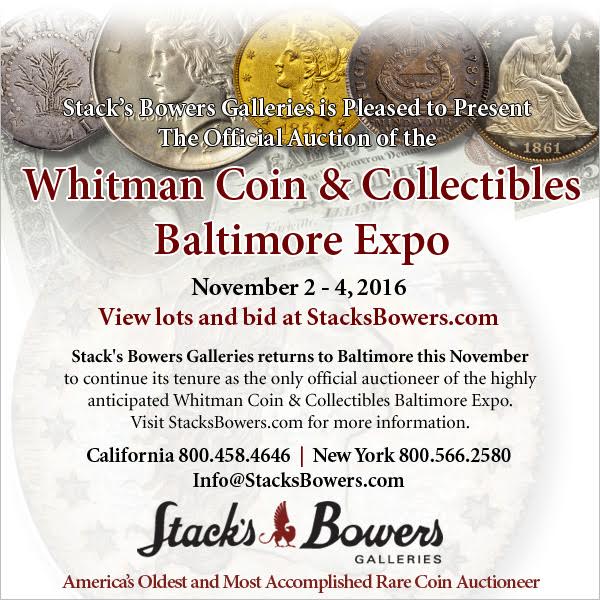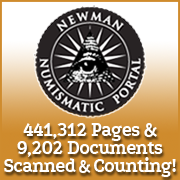
About UsThe Numismatic Bibliomania Society is a non-profit organization devoted to the study and enjoyment of numismatic literature. For more information please see our web site at coinbooks.org SubscriptionsThose wishing to become new E-Sylum subscribers (or wishing to Unsubscribe) can go to the following web page link MembershipThere is a membership application available on the web site Membership Application To join, print the application and return it with your check to the address printed on the application. Print/Digital membership is $40 to addresses in the U.S., and $60 elsewhere. A digital-only membership is available for $25. For those without web access, write to: Terry White, Treasurer AsylumFor Asylum mailing address changes and other membership questions, contact Terry at this email address: terrywhite5475@yahoo.com SubmissionsTo submit items for publication in The E-Sylum, just Reply to this message, or write to the Editor at this address: whomren@gmail.com
BUY THE BOOK BEFORE THE COIN |
- WAYNE'S WORDS: THE E-SYLUM NOVEMBER 6, 2016
- NEW BOOK: KNIGHTS' GOLD
- NEWMAN PORTAL UPGRADES CAMERAS TO SCAN MARIS
- THOUGHTS ON THE DEADWOOD RACKETEER NICKEL
- FURIOSO PLATES, W.L. ORMSBY, AND BANKNOTE FRAUDS
- NOTES FROM E-SYLUM READERS: NOVEMBER 6, 2016
- BLUNT: OPERATOR FOR THE TEETH AND BLEEDER
- GEORGE F. KUNZ: NOT ON THE LUSITANIA
- STRATIFIED ANTHROPOMORPHIC DESIGN
- VOCABULARY TERM: CLASSICAL
- DANIEL RECK (1834-1921)
- VIDEOS: BUREAU OF ENGRAVING AND PRINTING IN 1920
- EUREKA! A NEW GENERATION OF GOLD MINERS
- REGISTER OF DIES: HEADS AND TAILS
- A TOUR OF THE SAN FRANCISCO MINT IN 1856
- WAYNE'S NUMISMATIC DIARY: NOVEMBER 6, 2016
- COINTALK COIN CONTEST GIVEWAY CHALLENGE
- TEENAGERS DISCOVER 1,200-YEAR-OLD COIN
- BROTHERS DESIGN CANADA'S NORTHERN LIGHTS COIN
- CANADA'S SESQUICENTENNIAL CIRCULATING COINS
- AUSTRALIA’S PRIME MINISTER ASKED ABOUT FIVE CENT PIECE
- THE COIN JEWELERY OF STACEY LEE WEBBER
- ENGRAVED COINS OF SHAUN HUGHES
- FEATURED WEB SITE: COIN TALK
Click here to access the complete archive
To comment or submit articles, reply to whomren@gmail.com
WAYNE'S WORDS: THE E-SYLUM NOVEMBER 6, 2016
We have no new subscribers this week; our count is 2,031. I ran out of time this week and wasn't able to get in everything people sent me; I'll see if I can catch up on the backlog next week. Meanwhile, my apologies.
This week we open with one new book, a Newman Numismatic Portal update, and thoughts on the Deadwood Racketeer Nickel. Other topics this week include Furioso plates, a London dentist's token, dealer Daniel Reck, modern gold miners, and the San Francisco Mint in 1856.
To learn more about the Knights of the Golden Circle, A Historic Sketch of the Coins of New Jersey, Jacob Perkins, Commemorative Half Dollar holders, medallic anthropomorphism, the Register of Dies for the Philadelphia Mint and Branch Mints, Charles E. Clapp (Sr. and Jr.), Castorland Jetons, and Canada's new coin designs, read on. Have a great week, everyone!
Wayne Homren
Editor, The E-Sylum

NEW BOOK: KNIGHTS' GOLD
Regarding his new book about the Baltimore Gold Hoard, author Jack Myers writes:
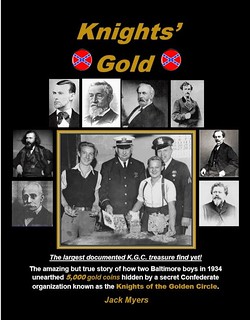 Knights' Gold tells the story of how two boys in 1934 Baltimore unearthed a pot filled with 5,000 gold coins. For the past 80+ years the coins were thought to have been the life savings of a wealthy miser. But new and startling evidence now links the coins to the Knights of the Golden Circle, a Confederate secret society determined to put an end to the Lincoln presidency. Now out on Kindle and eBooks. Will be out in paperback soon.
Knights' Gold tells the story of how two boys in 1934 Baltimore unearthed a pot filled with 5,000 gold coins. For the past 80+ years the coins were thought to have been the life savings of a wealthy miser. But new and startling evidence now links the coins to the Knights of the Golden Circle, a Confederate secret society determined to put an end to the Lincoln presidency. Now out on Kindle and eBooks. Will be out in paperback soon.
For more information, or to order, see:
Knights' Gold Kindle Edition
(www.amazon.com/Knights-Gold-Jack-Myers-ebook/dp/B01M4FGK0I/ref=sr_1_1)
Len writes:
While there is no smoking gun, Myers uncovers a long string of either coincidence or causation (the reader can decide which!) linking Andrew J. Saulsbury, the likely depositor of the gold, and prominent Confederate sympathizers in Baltimore. The connections are tantalizing, and would have been included in my book had I found them at the time.
The coins were the property of the Knights of the Golden Circle, a pro-Confederate secret society.
I researched the owners of the treasure house from the time of the burial of the gold coins. Coins were all dated 1834-1856
1. Captain John J. Mattison (a mariner) owned the house on Eden St from 1851-1865.
2. Andrew Saulsbury (candle and soap executive) owned the house from 1865-1873 until his death (his widow remained until 1889). Saulsbury bought house from Mattison.
- Captain Mattison was involved in the illegal African slave trade and had his ship seized for bringing slaves from Sierra Leone to Cuba.
- It is known that the KGC was trying to break the international slave trade ban by sending "secret slaver" ships to Africa. Cuba was their intended capital.
- Saulsbury, a known ardent Southern sympathizer, worked for James Armstrong & Assocs. makers of fine soaps and candles.
- CEO of Armstrong & Assocs. was Charles Webb, Jr. who was also the head of the Maryland Freemasons (Grand Master)
- Charles Webb's "Companion Mason" who sponsored him for the Grand Master position was Arkansas' Albert Pike, suspected head of the KGC.
- Saulsbury's best friend at the candle company was Thomas Armstrong, nephew of the company founder.
- Thomas Armstrong lived at the local Fountain Hotel, a known rebel hangout and haunt of John Wilkes Booth.
- Years later, when the hotel was torn down, a tin box containing 2,000 gold coins was found on the property
- So, Charles Webb was directly linked to the national leader of the KGC, and he has two friends and direct reports with caches of gold under their residences.
- Charles Webb and Freemason brother James Webb served on the BOD of a related Armstrong Co, the American Fire Insurance Co., along with James Armstrong.
- "Secret Slaver" Captain John Mattison also served on the BOD with the Webbs and Armstrong.
- Charles Webb was important with his "Committee of 20" in backing the Southern Democrats for office in Baltimore. Southern Democrats were pro-slavery.
- Webb especially backed two friends for office, Mayor George Brown and Police Marshal George Kane (a slaveholder).
- Both Kane and Brown were arrested on order from President Lincoln on charges of treason in 1861.
- Booth swore retribution against the people who had arrested his friend, George Kane.
- Kane participated in the April, 1861 bridge burnings to prevent Union troops from reaching Washington, DC. He was said to have been assisted by J.W. Booth.
- Kane wrote to Lincoln and Seward from prison and promised they would "hear from him at the appropriate time."
- When Kane got out of prison, he went to Montreal to join the Confederate Secret Service which conducted clandestine campaigns against the North.
- Kane was in charge of the aborted raid on Johnson Island in the Great Lakes, site of a military prison containing captured Confederates.
- When Booth devised a plan to kidnap Lincoln, he went to Montreal to present his plan to the Montreal Confederates, including his friend Colonel Kane.
- Kane's Montreal associate Dr. Luke Blackburn runs a "Yellow Fever Plot" to send infected clothes to Northern cities. Clothes are prepared and shipped from Fountain Hotel.
- After the war, Kane got a job on the Jones Falls Commission, the Baltimore water authority, probably with the help of Charles Webb.
- Kane left the Jones Falls Commission and was replaced by Andrew Saulsbury, who now owned the house with the treasure.
- Kane runs for sheriff and wins. Later runs for Mayor of Baltimore and wins.
- Mayor Kane appoints friend and long-time supporter Charles Webb to be his tax collector.
- Saulsbury dies suddenly in treasure house. Buried coins are not discovered until 1934. Coins worth north of ten million dollars today.
I believe the coins were collected as dues and initiation fees of the Baltimore chapter of the KGC. It was thought that Maryland had over 3,000 KGC members. John Wilkes Booth lived only four blocks from the treasure site, and also close to the second treasure site of the Fountain Hotel. Saulsbury's 1859-60 residence matches the description of the house where Booth was allegedly inducted into the KGC in 1859 (house in the neighborhood with paintings of Southern heroes and politicians hanging on the parlor walls.)
To read earlier E-Sylum articles, see:
REVIEW: TREASURE IN THE CELLAR BY LEONARD AUGSBURGER
(www.coinbooks.org/esylum_v11n28a02.html)
NUMISMATIC BOOKIE: 'TREASURE IN THE CELLAR'
(www.coinbooks.org/esylum_v18n32a12.html)
THE BOOK BAZARRE
NEWMAN PORTAL UPGRADES CAMERAS TO SCAN MARIS
Newman Portal Upgrades Cameras to Scan Edward Maris’s A Historic Sketch of the Coins of New Jersey with a Plate
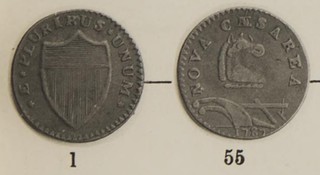
Measuring in at a massive 19” x 12”, Edward Maris’s 1881 analysis of New Jersey copper die varieties is one of the most physically imposing volumes in American numismatic literature. The Newman Portal scanning lab at Washington University in St. Louis recently upgraded to Nikon D810 cameras capable of 36 megapixel resolution, and Maris’s elephant folio was the perfect test case.
Loaned from the Eric P. Newman rare book collection, the immediate focus of this work is the two (facing) plate pages that depict the entire set of die marriages. The Newman Portal scans of these plates can be expanded and are easily sufficient for die attribution. Remarkably, none of the usual aggregator sites (Google Books, Internet Archive, HathiTrust) had previously attempted a scan of this book – no doubt due to its unwieldy size.
While a faithful and useful reproduction of the original, this digital representation does not quite duplicate the grandeur of a physical copy. At the recent Baltimore Whitman show, the C4 club displayed a copy of the Maris folio with corresponding examples of New Jersey cents overlaid on the two photographic plates. The Internet is a fine tool for research, but exhibits such as this are a compelling reason to attend coin shows.
Link to A Historic Sketch of the Coins of New Jersey on Internet Archive:
https://archive.org/details/historicsketchof1881edwa

THOUGHTS ON THE DEADWOOD RACKETEER NICKEL
Dave Bowers writes:
The last issue of E-Sylum has to go in the E-Sylum Issues Hall of Fame!
Joel Orosz writes:
The issue had such a wide mix of interesting topics (an actual verifiable racketeer nickel!) that it would be a strong contender in my estimation. I had just about consigned the racketeer nickel story to legendary status, and now they find one. Just goes to show that we skeptics aren't always right...
Bob Evans writes:
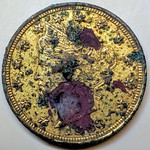 It appears that the plating has been breached somewhat, exposing the underlying nickel alloy to some irreversible corrosion. The colors present in the dark areas are fairly typical of buried copper alloys that have mineralized. Conservation would be somewhat pointless I would think. Plenty of plating remains to establish it as a "Racketeer Nickel," and the provenance of the piece is self-authenticated by the condition, looking very much like a buried "treasure."
It appears that the plating has been breached somewhat, exposing the underlying nickel alloy to some irreversible corrosion. The colors present in the dark areas are fairly typical of buried copper alloys that have mineralized. Conservation would be somewhat pointless I would think. Plenty of plating remains to establish it as a "Racketeer Nickel," and the provenance of the piece is self-authenticated by the condition, looking very much like a buried "treasure."
I would think it would be worth more than than the "less than 10 cents" cited by the archaeologist, but then this is the somewhat political position always taken by archaeologists opposed to any sort of "commercial archaeology." Myself, I do not find the information requirements of the two approaches to be any different. Provenance and diligent forensic science enhance the value of finds, whether monetary value or historical importance.
Cool piece.
To read the earlier E-Sylum article, see:
THE DEADWOOD RACKETEER NICKEL
(www.coinbooks.org/esylum_v19n44a28.html)

FURIOSO PLATES, W.L. ORMSBY, AND BANKNOTE FRAUDS
Regading Wendell Wolka's question about "Furioso Plates", Dave Bowers writes:
Some years ago when I was researching obsolete notes for my Encyclopedia of Obsolete Paper Money I delved into Waterman L. Ormsby at great length.
I don’t have the citation on hand, but his idea of creating custom full-face vignettes of different characters for different banks was called FURIOSO. One of my favorites of such is attached.
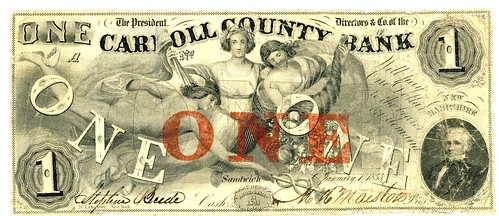
Wendell writes:
Thanks! Just did an article on Ormsby for The Numismatist. My take: while not an out and out crook, 2/3s of his customers were fraudulent concerns; a percentage higher than his peers. I conclude he didn't ask many questions or may have simply been the low cost supplier.
With regard to Ormsby being semi-fraudulent or questionable, nearly all of the other bank note companies asked no questions either. This seemed to be universal practice!!! The matrix seems to have been people who approached Ormsby, ABNCo, or others stating they planned to get state charters. The bank note companies very obligingly printed whatever they asked for.
This was most endemic in the District of Columbia which had no oversight at all, except Congress, whose committees met erratically and often ignored requests for charter extensions from established banks.
As to Ormsby, he cast himself as a savior of the engraving industry. In my studies of him I have found him to be a man of high intellect. In his 1853 tell-all book he pointed out many abuses in the banknote engraving industry—creating enmity between him and the other firms. Although he was involved in fake labels for patent medicines (but whether he was aware is uncertain) and printed his share of notes for non-existent banks, I have found NOTHING to suggest that he was any more culpable than those who criticized him.
The poster example is Jacob Perkins who printed endless notes for the Farmers Exchange Bank of Gloucester, RI, and the Hillsborough Bank of Amherst, NH—in the same time that the frauds were widely reported in the papers!
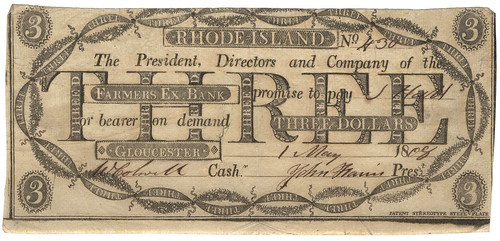
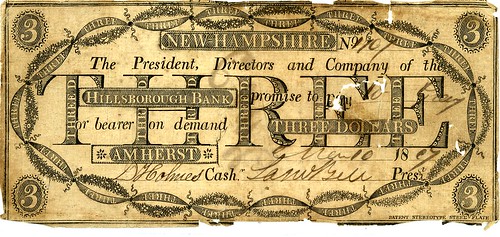
Samuel Bell, president of the Hillsborough Bank in Amherst, was NEVER investigated or charged and later became GOVERNOR of New Hampshire! His official bio does not mention this connection (I am a trustee of the NH Historical Society).
As to Andrew Dexter, perpetrator of the Farmers Exchange Bank fraud, he was never prosecuted. He hopped, skipped, and jumped to the South, did well in real estate, and today Dexter Avenue in Montgomery, Alabama, leading to the State Capitol, is named in his honor.
Another Darwin Award goes to the perpetrators of the the Bank of New England of Fairmount, Maine fraud and their banknote company accomplice. There are two problems here: (1) There never was such a bank, and (2) there never was such a town in Maine. Fraudsters ordered about $500,000 face value of these bills from the highly esteemed Rawdon, Wright, Hatch & Edson, New York. Apparently, the firm did not make even a basic check on the standing of this bank! According to gadfly W.L. Ormsby, who had the nasty habit of pointing out frauds, these were “for the sole purpose of altering them to represent the issues of the New England Bank, Boston. The best are often deceived.” Lots of fun for numismatists who collect these!
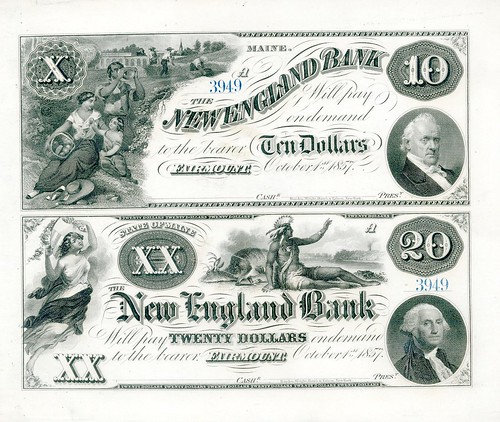
To read the earlier E-Sylum article, see:
NOTES FROM E-SYLUM READERS: OCTOBER 30, 2016 : Furioso Plate
(www.coinbooks.org/esylum_v19n44a11.html
THE BOOK BAZARRE
NOTES FROM E-SYLUM READERS: NOVEMBER 6, 2016
1987 NGC Black Label Holder Sold Again
David Schwager writes:
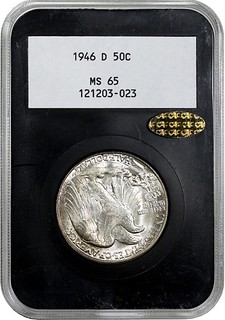 In case anyone has "non-buyer's remorse" and wants another chance at the NGC black holder mentioned in the last E-Sylum, it is currently for sale by well-known Massachusetts dealer Coin Rarities Online. Asking price is $4,750. They sent the slab to CAC and it now has a gold sticker.
In case anyone has "non-buyer's remorse" and wants another chance at the NGC black holder mentioned in the last E-Sylum, it is currently for sale by well-known Massachusetts dealer Coin Rarities Online. Asking price is $4,750. They sent the slab to CAC and it now has a gold sticker.
To read the complete article, see:
1946-D Walking Liberty 50¢
(http://www.coinraritiesonline.com/index.php?page=search&task=det_item&item_id=430191)
To read the earlier E-Sylum article, see:
1987 NGC “BLACK LABEL” HOLDER SOLD
(www.coinbooks.org/esylum_v19n44a20.html)
Commemorative Half Dollar Holders Sought
Ginger Rapsus writes:
I'm seeking information and pictures of original holders for commemorative half dollars: Booker T. Washington, Washington/Carver. Can't find much online or in reference books.
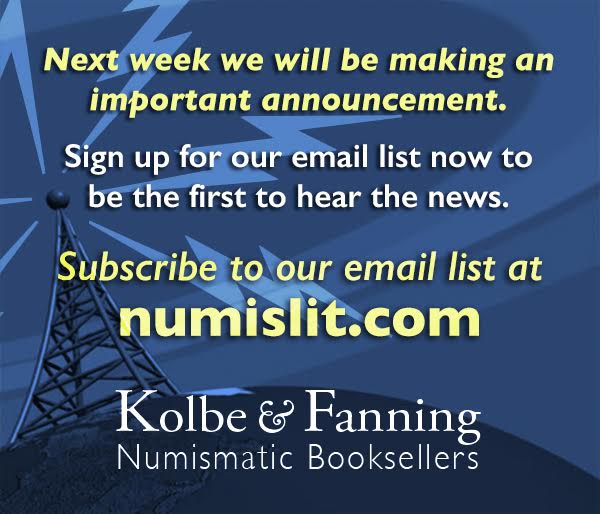
BLUNT: OPERATOR FOR THE TEETH AND BLEEDER
David Pickup writes:The article on dentistry and banknotes reminded me of a piece I have that was made for a dentist. My findings were published in the Token Corresponding Society Bulletin.
A recently purchased George II halfpenny has the following inscription engraved on the reverse,
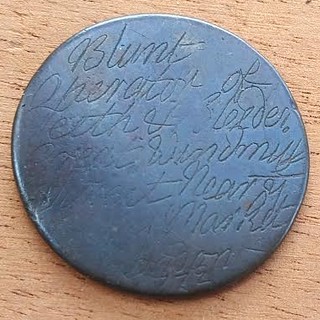 Blunt /
operator of /
teeth & bleeder /
Great Windmill /
Street nearby /
– market /
London /
1772
Blunt /
operator of /
teeth & bleeder /
Great Windmill /
Street nearby /
– market /
London /
1772
A search of the Sarah Banks’ collection of trade cards at the British Museum located a trade card which reads as follows,
BLUNT / Opperator for the teeth / And Bleeder / The Upper End of / Great Windmill Street / Opposite the / Hay Market
Blunt held the joint occupations of “operator for the teeth” meaning a person who carries out operations and “bleeder”. Presumably the use of the word “operator” suggests something more sophisticated than a person who simply pulled out teeth.
During the eighteenth century bloodletting was common and universal in the treatment of disease. It did not fall out of use until the following century.
For more information about the Token Corresponding Society, see:
http://thetokensociety.org.uk/
To read the earlier E-Sylum articles, see:
IMAGES OF DENTISTRY ON PAPER MONEY
(www.coinbooks.org/esylum_v19n44a31.html)
WAYNE'S NUMISMATIC DIARY: OCTOBER 30, 2016
(www.coinbooks.org/esylum_v19n44a09.html)

GEORGE F. KUNZ: NOT ON THE LUSITANIA
-
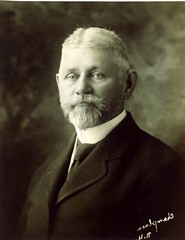 The name is GEORGE FREDERICK KUNZ. It is never spelled Kuntz.
The name is GEORGE FREDERICK KUNZ. It is never spelled Kuntz.
- The Lusitania sailed from New York on Saturday, January 30, 1915.
- The Lusitania reached Liverpool on Saturday, February 6, 1915.
- George F. Kunz attended Pilgrims of the United States luncheon in NYC on January 28, 1915.
- On Tuesday, February 9, 1915, Kunz attended a Pan- American Society luncheon at India House in NYC.
- On Tuesday, February 16, 1915, Kunz attended American Institute of Mining Engineers dinner, Hotel Astor, NYC.
- Kunz could not have been back in NYC from England that quickly. Indeed, Col. Edward M. House and his wife sailed on the Lusitania on Jan. 30, 1915.
- House is mentioned as a passenger in the NY Times.
- House was escorting 21-year-old Nona H. McAdoo and her friend who were going to nurse wounded soldiers in a hospital in France. Nona was a daughter of Sec. of Treasury, William G. McAdoo.
- Other prominent people are mentioned as passengers; but not George F. Kunz.
- Dr. Kunz was prominent enough (and he liked publicity) to be mentioned by the newspaper.
- George F. Kunz is known to me primarily as the most important gemologist for Tiffany & Co.; but he had many other interests.
Greg Burns writes:
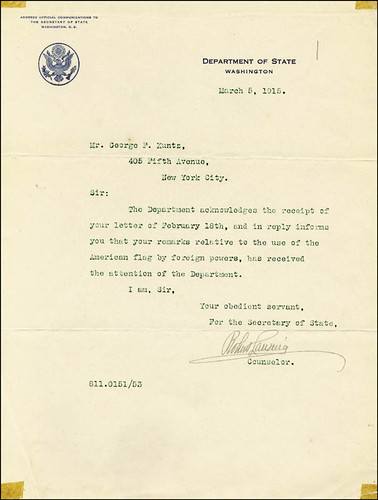 I’ve attached a scan of the Robert Lansing letter showing the Kuntz spelling and the mailing address used by Kunz/Kuntz at Tiffany’s (405 Fifth Avenue). I see a number of web references that use the Kuntz spelling, though don’t doubt that Kunz was George’s correct and preferred spelling (virtually all independently published accounts of the early 20th century follow the convention of Kunz). Perhaps Lansing’s use of Kuntz on his reply letter was an artifact of dictation and transcribed phonetically.
I’ve attached a scan of the Robert Lansing letter showing the Kuntz spelling and the mailing address used by Kunz/Kuntz at Tiffany’s (405 Fifth Avenue). I see a number of web references that use the Kuntz spelling, though don’t doubt that Kunz was George’s correct and preferred spelling (virtually all independently published accounts of the early 20th century follow the convention of Kunz). Perhaps Lansing’s use of Kuntz on his reply letter was an artifact of dictation and transcribed phonetically.
Kay’s very helpful comments on the itinerary of Kunz indicate that my inferences on George’s presence on the Lusitania were undoubtedly wrong, and his letter to the State department must have simply been to voice an opinion on the subject, not to reflect a personal observation.
Ten years or so ago I scoured many of the available resources regarding the January 30th voyage in an effort to confirm/refute Kunz’ presence on the Lusitania (including Lusitania expert Eric Sauder), though to no avail. Now the answer appears to be that, no, Kunz did not personally witness the “abuse of neutral flags” as I had imagined.
Thanks so much to Kay and her helpful information on the Kunz itinerary in the days/weeks following that voyage. Just another example of the tremendous benefits that The E-Sylum brings to us all.
Kay adds:
Robert Lansing’s 1915 letter to George F. Kunz should have been addressed to 401 Fifth Avenue, not 405 Fifth Avenue. Tiffany & Co.’s official address was 401 Fifth Avenue in the time period 1905 – 1940, located at the SE corner of 37th Street.
Tiffany & Co. moved to its present location (727 Fifth Avenue @ 57th Street) in 1940, vacating 401 Fifth Avenue; although 401 still stands with other owners and uses.
To read the earlier E-Sylum article, see:
NOTES FROM E-SYLUM READERS: OCTOBER 30, 2016 : George F. Kuntz
(www.coinbooks.org/esylum_v19n44a11.html)
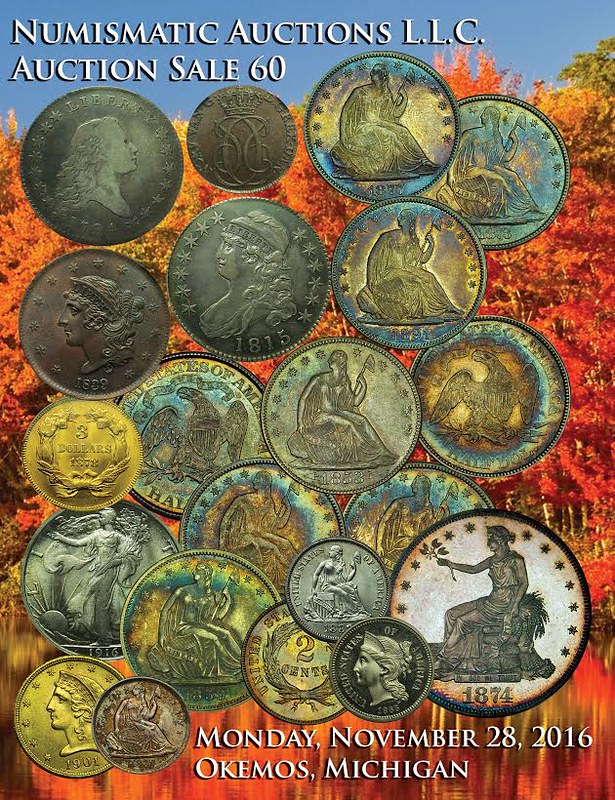
STRATIFIED ANTHROPOMORPHIC DESIGN
While the article on anthropodermic books was a bit gruesome in last week’s E-Sylum I recall the use of the related word "anthropomorphic," meaning “human-like.” With this meaning in mind I have used it in cataloging a medal or two, one of which was a forester’s national association which illustrated, obviously, a tree on the reverse. All the leaves were human faces. I have the term listed in my Encyclopedia.
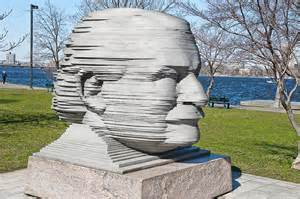 I had to use this word to describe a sculpture recently. The statue in Boston’s Charles River esplanade is composed of layers to form the head of Arthur Fiedler, famed conductor of the Boston Pops. How do you describe this statue? I even inquired of the editors of Merriam-Webster’s dictionary for the proper term.
I had to use this word to describe a sculpture recently. The statue in Boston’s Charles River esplanade is composed of layers to form the head of Arthur Fiedler, famed conductor of the Boston Pops. How do you describe this statue? I even inquired of the editors of Merriam-Webster’s dictionary for the proper term.
Their reply was “layers” a term used by the artist, Ralph Helmlck. In my 40 years working with sculptors I had learned artists are poor wordsmiths, with some exceptions, of course, like Malvina Hoffman. “Layers” sounded like I was describing a cake. I wanted something like “striated” layers. Here is what I wrote to describe this unusual sculpture:
The Arthur Fiedler Statue consists of 83 layers of aluminum, each stratum is shaped slightly different from its neighbor, which when stacked forms the image of a human-like face. The sculptural form of stratified anthropomorphic design is rare in the art field. The symbolism of the layers is said to be “a sense of movement or variation like that of a violin which Fiedler played” and changes as a viewer approaches the statue.
As a numismatic connection some years back I wanted a head of Abraham Lincoln in this sculptural technique in medallic size. I contacted a dozen medallists. Not one taker; all refused such a commission.
To read the earlier E-Sylum article, see:
THE ANTHROPODERMIC BOOK PROJECT
(www.coinbooks.org/esylum_v19n44a34.html)
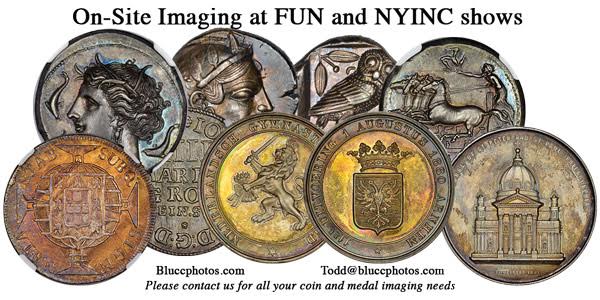
VOCABULARY TERM: CLASSICAL
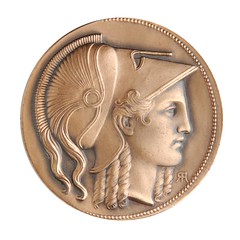
This is an extreme example of Classical design in a modern medal by Robert I. Aitken for its device from ancient coins. Note the dots in an arc just inside the rim. This inspired the use of dentiles in 19th century coin designs.
Classical – Design with emphasis on harmony, proportion, balance, and simplicity. It places great importance on beauty. First employed by artists in Greek and Roman times, and certainly evident in their coin designs. Thus it is the oldest of all formal art movements. When it was revived in Europe in late 18th and early 19th centuries it was called neoclassical. When it is copied in modern times, perhaps with less emphasis on beauty, it is called pseudoclassical.
Art Movements. Artistic styles having common methods of expression or presentation and employed by a number of artists. Determining an art movement depends on recognizing a style used by more than one artist in the treatment of their subjects; for coin and medal design it is the use of similar shapes, texture and artistic mannerisms. Naming these styles aids the art community in writing and speaking of each art style as its own entity. The artists who create in similar style are often close in time or location (as one artist may imitate another whose style he admires). When close in time it is sometimes called a “period” or a movement.
Art movements have changed with time. Early art stressed religious themes in fixed style. The Renaissance served as a rebirth with freer expression. In later years new movements arose as artists experimented more, giving birth to those art movements listed here (and many others). Artists sometimes trained together giving rise to a collective work of a school of art. In other forms of art, as painting and sculpture, these styles are often called “ism” as impressionism.
Some typical art movements – classical, renaissance, abstract, modern – indeed do apply to medallic art; many others do not, as constructivism, cubism, dadaism, minimalism, pop art, surrealism for example. The requirements of coins and medals, predominately that being reproduced in metal of monochromatic color, prohibit some art movements in medallic design. Thus the art movements of painting, where color is so dominate, do not transfer to medallic art, the art movements of sculpture, however, are more inviting. (Color in medallic art can be implied by texture; there is a set scheme of line direction that indicates color. See HERALDRY.)
In modern times strict art movements have somewhat disappeared, replaced by contemporary art, where individualism and diversity prevail. Thus coin and medal artists develop their own personal style of medallic design (and no other artist as yet has imitated their style). See STYLE and TECHNIQUE.
Native American Art Movements. “Federal Style” should be mentioned (see list) since it was a truly American creation. The first coins struck at the early U.S. Mint were created in a somewhat neoclassic style. However, the use of the head of Liberty, the stylized eagle and stars as subsidiary devices – even though influenced by French coin designs – were uniquely American in presentation.
Lesser known, the Philadelphia School of Art occurred in the second half of the 19th century. It was influenced by the Federal Style but without subsidiary devices. It was usually of a single obverse device, and otherwise pseudoclassic. Obviously, it flourished among Philadelphia coin and medal artists, both inside and outside the U.S. Mint, but the work of all private medal makers in Philadelphia following the Civil War was of this stark, stiff style devoid of decoration and embellishment.
MEDALLIC OBJECTS can be traced to the eight productions by six American artists in 1965. Perhaps this can be said to be the first modern art in American art medals. While America created the first medallic objects, the French developed this new media to a fine art in its own right.
References: CLASS 03.2
D21 {1971} Vermeule. Introduces term ederal style for early American coins.
E25 {2014} Johnson, Who’s Who Among American Medallists . Introduction identifies eight art movements employed in American coins and medals.
Note: This is a stub of the total entry which includes descriptions of twenty art movements.
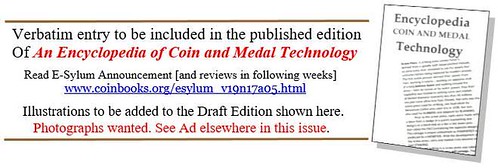
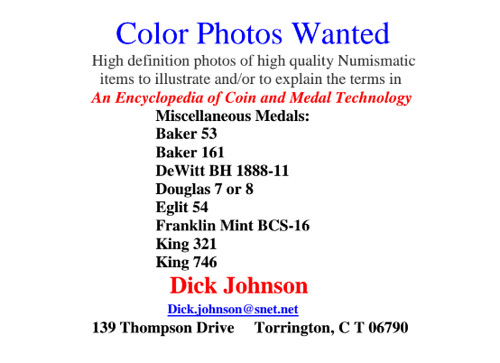
DANIEL RECK (1834-1921)
Daniel Reck (1834-1921), coin dealer at Dayton, Ohio. He served in the U. S. Army during the Civil War from 1861 to 1865 with the rank of Corporal. In 1880 he lived at 7 Bimm's Park, Dayton, Ohio, where he worked as a Pension Claim Agent. In 1881 he is listed as an attorney. In the City Directory of 1882 he is listed as a "Detective" and in 1884 he was living at 521 South Main Street, Dayton.
In 1895 he began corresponding with the Chapman Brothers. There are over sixty pieces of correspondence to the Chapmans in the Lupia Numismatic Library, Special Collection, The Chapman Family Correspondence Archive. Several pieces show he sold U. S. gold coins. Some of the mail is annotated with shorthand letters inscribed on them by the Chapmans. He never seems to have joined a numismatic association, society or club, but rather, collected and dealt independently. In the 1897, City Directory he is listed as a "Collector of rare coins" living at 729 West 5th Street, Dayton, Ohio, with his wife Sarah A. Tonney Reck (1834-1922). His dealings with the Chapman Brothers were typical of dealers who sent queries soliciting either to buy specific coins for their clientele or sell what inventory they had on hand. Below is a typical example of a solicitation to sell.
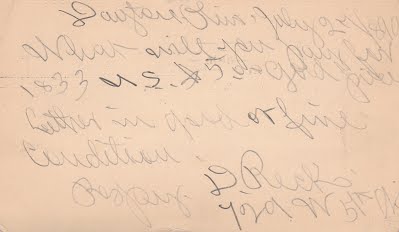
From 1900 on he is variously cited in the City Directory as either a "Coin Dealer" or "Numismatist."
In 1912 he is listed living at 1815 South Wayne Avenue, Dayton. He died on January 16, 1921. He is buried at the Woodland Cemetery Arboretum, Dayton, Ohio. After the death of her husband Sara A Reck moved to South Bend, Indiana. She died in April 1922 and is buried with her husband.
To read the complete article, see:
RECK, DANIEL
(https://sites.google.com/a/numismaticmall.com/www/numismaticmall-com/reck-daniel)
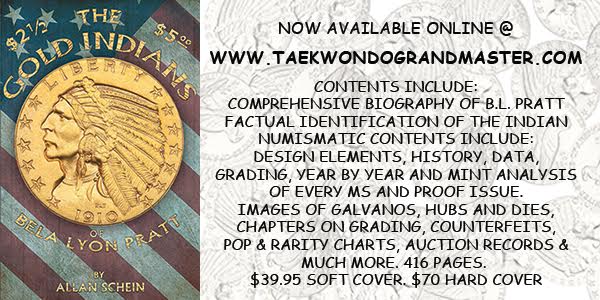
VIDEOS: BUREAU OF ENGRAVING AND PRINTING IN 1920
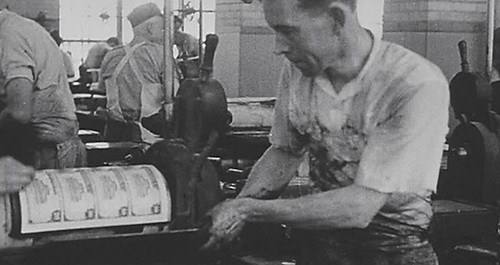
A nine-second promotional video from a service called Framepool offers a rarely seen glimpse of the currency printing process in the days of four-subject sheets.
The clip is one of several offered for sale under the subject heading “Bureau of Engraving and Printing / Money Printing Company / Washington / USA / 1920.” It shows the work involved in printing one sheet of currency, that if you look closely enough, you will see it is from the Third Charter Period of national bank notes. The scene is a far cry from the promotional videos put out by the BEP today and is a reminder of how far things have come.
Other clips include ones showing plate engraving, counting, inspecting, and other aspects of the production process.
To read the complete article, see:
Stock footage company marketing video clips of BEP operations in 1920
(www.coinworld.com/news/paper-money/2016/10/get-a-look-at-note-production-at-bep-in-1920.html)
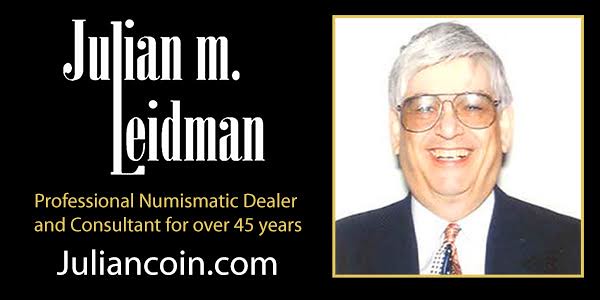
EUREKA! A NEW GENERATION OF GOLD MINERS
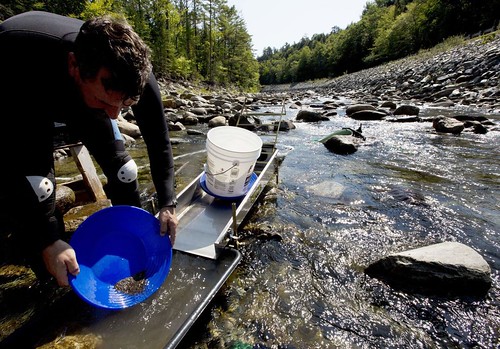
Al Davis Jr. cracks a smile as he spots a speck of gold glittering in a plastic pan full of muck pulled from a Vermont brook, revealing a gold tooth made from some earlier finds.
Davis, decked in waders and wearing a hat festooned with a tiny bottle filled with gold flakes, is part of a community of prospectors who number around 3,000 in New England.
Often equipped with little more than a shovel and a pan, they can be found knee-deep in streams and rivers on most summer weekends in places like Plymouth; Byron, Maine; and Bath, N.H.
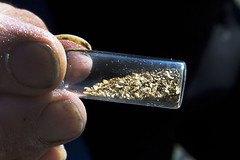 "There is something magical about it. You always keep coming out because you want to see if you can beat the one you got," said Davis, who has been mining for nearly half a century. "Can I get one a little bigger?"
"There is something magical about it. You always keep coming out because you want to see if you can beat the one you got," said Davis, who has been mining for nearly half a century. "Can I get one a little bigger?"
But these days, the rivers Davis and other aging prospectors once had to themselves are getting more crowded, they say, as a younger generation of miners in the Northeast and Pacific Northwest gives prospecting a try. Old-timers are seeing new clubs on Facebook and people taking gold mining classes. Some newbies are turning to mechanized mining means, raising environmentalists' hackles.
Miners attribute the growth to people seeking more solace in the outdoors, to shows like "Gold Rush" and "Yukon Gold" that make mining seem adventurous and profitable, and to history buffs who want to trace the Appalachian gold belt, which stretches from South Carolina to Nova Scotia and sparked a gold rush in the 1800s.
Then there was Tropical Storm Irene, which hit Vermont in 2011. It sparked a gold frenzy after reports surfaced that the storm had disgorged precious metal into streams.
"It was a true gold rush," said Nelson Illinski, panning recently within shouting distance of Davis on the Buffalo Brook in Camp Plymouth State Park with his wife, Ashley, and their 2-year-old son, Shane.
Illinski, in many ways, represents the younger generation of miners. A mix of rugged outdoorsman and Brooklyn-style hipster, the 39-year-old from Arlington, Vt., runs a Facebook page about gold mining in the state and teaches a class that has attracted 300 people the past two summers.
"It's no longer like a hobby for most of us. It's become an obsession," Illinski said. "It gives you a rush to know that people have been digging gold for 200 years and you found a piece they missed."
To read the complete article, see:
Eureka! A new generation of gold miners heads for the hills
(www.pantagraph.com/lifestyles/eureka-a-new-generation-of-gold-miners-heads-for-the/article_2294ecf4-7815-5a9d-b34f-a4af630fa4b5.html)

REGISTER OF DIES: HEADS AND TAILS
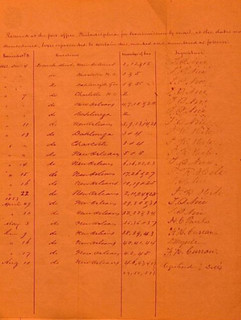 Did you ever wonder why
the Wiley-Bugert half dollar book refers to “head”
dies and “tail” dies? I always called them “obverse”
and “reverse,” and at coin shows you also hear numismatists refer to the “front” and “back” of a coin or
medal. The answer to the Wiley-Bugert mystery lies in
a 19th century document entitled “Register of Dies for the
Philadelphia Mint and Branch Mints.” Located in the National Archives, this volume covers deliveries of dies
from the Philadelphia Mint to the branch Mints for
the period 1839-1854. The Branch Mints covered in
this volume are New Orleans, Dahlonega, and Charlotte.
Did you ever wonder why
the Wiley-Bugert half dollar book refers to “head”
dies and “tail” dies? I always called them “obverse”
and “reverse,” and at coin shows you also hear numismatists refer to the “front” and “back” of a coin or
medal. The answer to the Wiley-Bugert mystery lies in
a 19th century document entitled “Register of Dies for the
Philadelphia Mint and Branch Mints.” Located in the National Archives, this volume covers deliveries of dies
from the Philadelphia Mint to the branch Mints for
the period 1839-1854. The Branch Mints covered in
this volume are New Orleans, Dahlonega, and Charlotte.
Bugert first looked at this document in the 1980s when the process to access this volume was not trivial. One had to know that the book actually exist- ed, then find the archive where it was deposited [Ed. - in the 1980s, it was DC, now it is Philadelphia] and then physically visit the National Archives at that location. Complicating matters was that the Internet did not exist, meaning all of this had to be coordinated by mail and phone. Once you got there you then had to navigate through the local archivists (sometime helpful, sometimes not) and call for the document. A staff member would take your call slip, go the stacks, and hopefully return with the document. If you were lucky there was a working photocopier to capture images [Ed. - and the staff member would permit photocopying—often not!], otherwise you had to work the old fashioned way and copy the information with pencil and paper.
The advent of the Internet is slowly changing all of this. Several years ago Bob Julian determined to systematically scan large amounts of material in the National Archives with an eye toward making this information publicly accessible. Julian applied to the Central States Numismatic Society’s author grants program, which generously donates awards of several thousand dollars to aspiring authors. Awards for 2016 were recently announced, but this is an annual affair, and prospective authors are highly encouraged to apply for next year.
With funding in hand, Julian arranged with local Philadelphians to physically perform the scanning. The National Archives are supportive of these efforts and digitizers such as Internet Archive have setup shop inside several of the Archives locations throughout the country. Over several years, Julian captured nearly 40,000 images and is making these available to the Newman Numismatic Portal and to other numismatic organizations.
The first document posted by the Newman Portal is the “Register of Dies” referred to above, and this is now accessible at https://nnp.wustl.edu/library/archivedetail/514794. In it we find that the Mint itself used the terminology “head” and “tail” to describe dies. One finds them also referred to as “head” and “tale” dies, but this is apparently a mis- spelling on the part of the Mint worker who happened to be recording die shipments that particular day. Documents such as these raise a whole host of related questions. Where are the die books for the period after 1854? Were all the dies used the same year they were shipped? How do these dies map to the known varieties for a particular year?
The answers to these questions are not always trivial, and one needs to keep in mind that records such as these are just one piece of the puzzle. Combined with actual observation of the coins, they start to make more sense, but there will always be mysteries. One of those mysteries will NOT be, “how do I access the die records in the National Archives?” That part is now solved, at least for the Liberty Seated coinage from 1839-1854.
To learn more about the Liberty Seated Collectors Club, see:
www.lsccweb.org

A TOUR OF THE SAN FRANCISCO MINT IN 1856
Interested readers wishing to see the original article with numerous illustrations, may wish to go to the Newman Portal at https://nnp.wustl.edu/library/book/517301?page=158 .
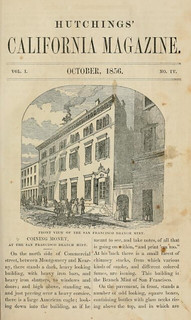 On the north side of Commercial Street, between Montgomery and Kearny, there stands a dark,
heavy looking building, with heavy iron bars, and
heavy iron shutters, to windows and doors; and high
above, standing on, and just peering over a heavy cornice, there is a large American eagle; looking down into
the building, as if he meant to see, and take notes, of
all that is going on within, “and print ‘em too”. At his
back there is a small forest of chimney stacks, from
which various kind of smoke, and different colored
fumes, are issuing. The building is the Branch Mint of
San Francisco.
On the north side of Commercial Street, between Montgomery and Kearny, there stands a dark,
heavy looking building, with heavy iron bars, and
heavy iron shutters, to windows and doors; and high
above, standing on, and just peering over a heavy cornice, there is a large American eagle; looking down into
the building, as if he meant to see, and take notes, of
all that is going on within, “and print ‘em too”. At his
back there is a small forest of chimney stacks, from
which various kind of smoke, and different colored
fumes, are issuing. The building is the Branch Mint of
San Francisco.
On the pavement, in front, stands a number of odd looking, square boxes, containing bottles with glass necks rising above the top, and which are the various kinds of acid used in the manufacture of gold and silver coin within.
In the street can be seen drays and wagons with men unloading supplies of various kinds for the Mint; express wagons with packages of the precious metal from all parts of the mines; men going up with carpet sacks hanging heavily on their hand, all desirous of having their gold dust converted into coin.
To learn more about the Liberty Seated Collectors Club, see:
www.lsccweb.org
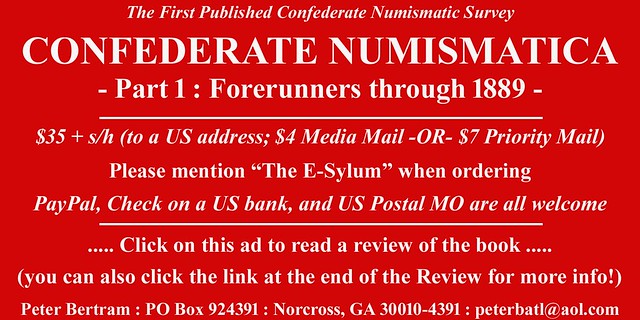
WAYNE'S NUMISMATIC DIARY: NOVEMBER 6, 2016
Dinner
This week brought another numismatic event for me. Thursday afternoon I left work early and pointed my car toward Baltimore for the Whitman Coin Expo. I parked in the Sheraton Hotel garage and made my way over to the convention center and the Stack's Bowers lot viewing room, where Len Augsburger said he'd likely be.
I didn't find him but I did quickly run into Joel Orosz who was also planning to meet up with Len. I pulled out my phone to give him a call. While it was still ringing we were greeted by Allan Schein. When I got Len on the line I learned he was at table 818.
Allan, Joel and I talked for a bit then walked together downstairs to the bourse floor. I stopped to register then caught up with everyone. Table 818 was Gerry Fortin's, but I caught up with everyone at Rich Uhrich's table - Bill Bugert was helping to man it. Bill and I spoke a bit about The E-Sylum, email newsletter distribution methods, and the two pieces I hoped to include today from the E-Gobrecht (which Bill so ably edits).
We ran into Darrell Low of the New York Numismatic Club. We spoke for a while, then me, Len and Joel headed over to Morton's for dinner. On the way we talked about our mutual friend the late John Burns, and at our table the discussion was mainly about the Newman Numismatic Portal.
Len and I ordered the crabcakes, and Len had the Miso Sea Bass. It was a very good meal (naturally). As we were finishing up, Dave Bowers and Mary Burleson of Whitman Publications sat down at a nearby table. Mary came over and gave us hugs. On our way out we talked a bit until their dinners arrived.
Colonial Coin Educational Forum
Next stop was the Colonial Coin Collectors Club Educational Forum at the Sheraton. The room was quite packed and I took a seat near the back next to Andy Newman. Very quickly Chuck Heck came over from a nearby table to profusely thank me for the help I'd given him in researching the Western Pennsylvania Numismatic Society. He was the third speaker, discussing the colonial coins owned by Charles E. Clapp, brother of WPNS co-founder George H. Clapp. Here's the official program:
7 pm: Joel Orosz and Len Augsburger: "Pattern Coinage of 1792"
8 pm: Syd Martin: "French Coinage for Colonial America"
9 pm: Chuck Heck: "Searching for Charles E. Clapp"
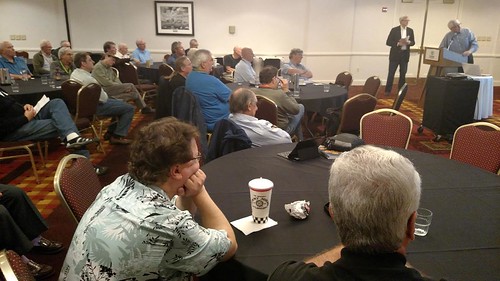
Up first were Joel and Len with a presentation on their highly anticipated book with Pete Smith on the coinage of 1792. They tag-teamed the presentation, taking turns for each segment. They made a case for considering the 1792 Half Dismes as regular issue U.S. coins rather than patterns, and showed compelling evidence that several were actually spent by Thomas Jefferson himself on a round trip from Philadelphia to his home in Virginia, Monticello. Several illustrations in the book are excellent original paintings by Pete Smith.
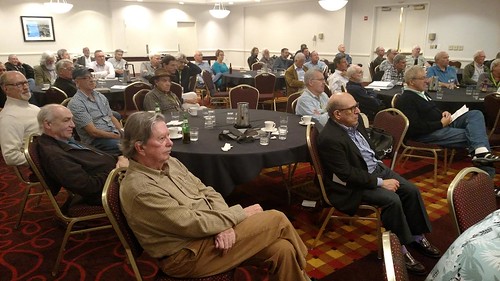
In the foreground of this picture are Chester Sullivan and Joe Esposito. At my own table was author Will Nipper - I spoke with him briefly at the first break. Next up as speaker was Syd Martin on the French coins struck for circulation in their North American colonies; as noted, Chuck Heck was up last.
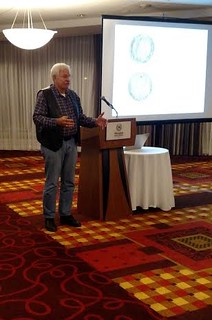
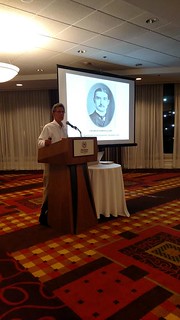
Left: Syd Martin; Right: Chuck Heck
I learned a lot from all the presentations. Syd made a convincing case for the official "French Connection" in Colonial coinages, and Chuck definitively cleared up a longtime mixup of Charles E. Clapp Sr. (a wealthy real estate investor and discerning numismatist) and his son Charles E. Clapp Jr., a bond broker who went bankrupt in the Great depression.
I had a long drive home to Virginia and left about 9:45 as Chuck was wrapping up his talk. What a great evening of numismatic scholarship! I made it home by 11pm, half the time of a midday trip.
Newman Portal Presentation
Friday morning I turned around and headed right back to Baltimore. I parked at the Pier V public garage and walked several blocks down Pratt toward the convention center. It was a sunny but slightly chilly morning.
I entered room 301 around 9:30 where the Liberty Seated Collectors Club meeting was already in full swing. Len gave a short presentation on various ways people collect the series.
After the break a new audience began trickling in, including David Gladfelter, Maureen Levine, Andy Newman, Bruce Smith, David Sundman and several others. Len would be speaking again, this time on the Newman Numismatic Portal. About a dozen or so people were present, including some new faces I hadn't seen before. There were a number of thoughtful questions about building and using the site.
The bulk of Len's presentation was on material in the portal relating to Colonial numismatics, both coins and paper money. But before starting that section he surprised me and got a laugh from all of us with a picture of my younger self from a Pennsylvania Association of Numismatists Clarion article digitized on the Newman Portal.
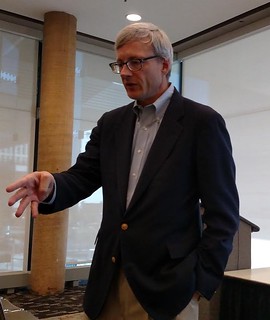
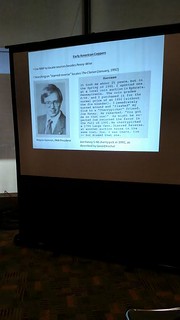
Left: Len Augsburger speaking; Right: a young Wayne Homren
Newman Portal User Forum
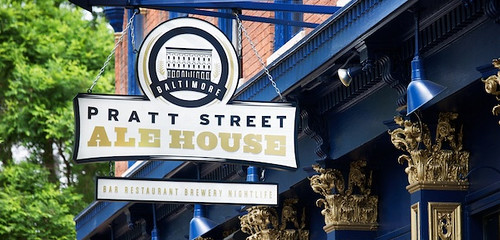
The next event was the big one of the day - our first-ever Newman Numismatic Portal User Forum. A gaggle of us walked together across the street to the Pratt Street Ale House where we'd reserved the 2nd floor library room for lunch.
Len set up his computer and projector for a different presentation focusing a little more on the how-to of using the portal. I mingled a little and met some new faces like John Bolger who sat at my table to my left. That's him using a tablet to access the portal. Jim Neiswinter and David Sundman were across from me, and the three of us brought it up on our phones. Catherine DiTuri of the American Numismatic Society came by to introduce herself, but couldn't stay because she was manning the ANS table at the show.
Counting some latercomers, we had about 24 in attendance, including Bruce Smith, Allan Schein, Roger Burdette, Jeff Rock, Erik Goldstein of Colonial Williamsburg, Andy Newman, Maureen Levine, Roger Moore, Jim Glickman Terri Venresca, Gamal Amer and American Numismatic Society Librarian David Hill. After we ordered our lunches, Len opened with a presentation, then I got up to give a deeper dive on some key topics including using the hierarchical menus vs. search terms, the "front end" vs. "back end" (Internet Archive), in-copyright vs. out-of-copyright works, and third-party content vs. content written or curated by NNP.
Jeff Rock opened a discussion of the impacts on the market for out of copyright numismatic literature. Andy Newman answered questions about the origin of the Newman Portal idea, and Eric's strong support for making numismatic information widely and freely available. We closed with some great stories about Eric. I noted that if it had been the evening and we all had drinks in our hand, I'd raise a glass for a toast thanking Eric for his gift to the hobby. We closed with a round of applause and a lengthy to-do list of ideas for new content and software features.
Here are some pictures.
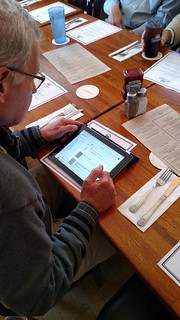
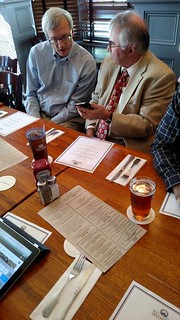
Left: John Bolger on his tablet computer
Right: Len and David Sundman
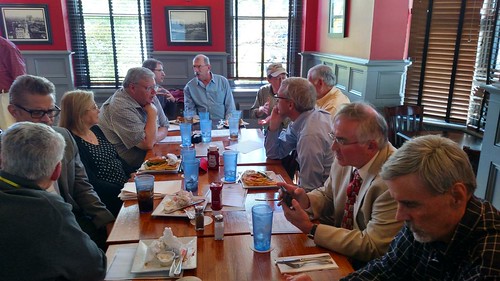
Front right: Jim Neiswinter
Far end: Allan Schein
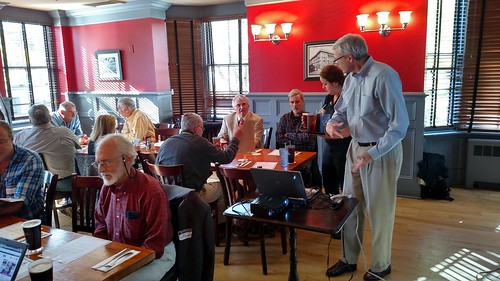
Standing: Len Augsburger; Seated in foreground: David Gladfelter
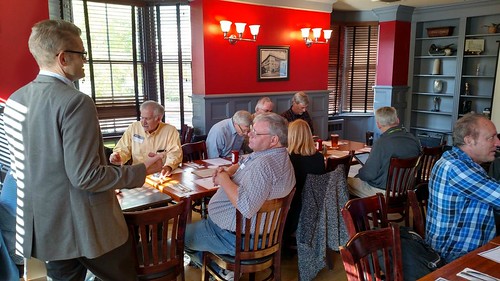
Standing: David Hill; Seated in foreground: Roger Burdette
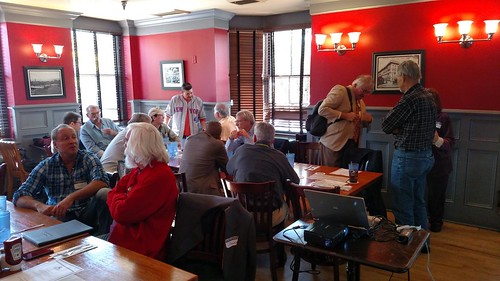
Seated in foreground: Jeff Rock and Bruce Smith;
At back in baseball jersey: Erik Goldstein
What a wonderful session! The room was lovely and the library theme was quite appropriate (the back wall was all shelving with some books for decoration). The food and staff were excellent. But the company and conversation were stellar. There was a clear sense of excitement over the existence and possibilities of the Newman Numismatic Portal.
Numismatic Literature Central: Charles Davis Table
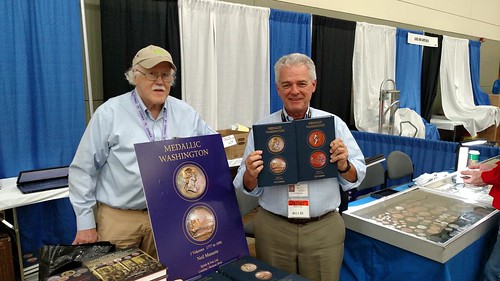
Charlie Davis and Neil Musante showcasing Neil's book, Medallic Washington
Back on the bourse floor I made a beeline for Numismatic Literature Central: the Charles Davis table. He had quite a large spread, which he shared with Neil Musante.
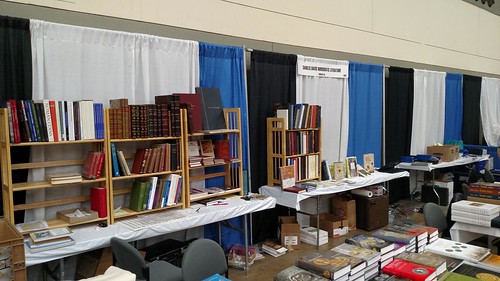
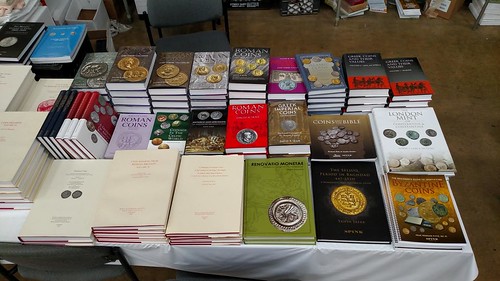
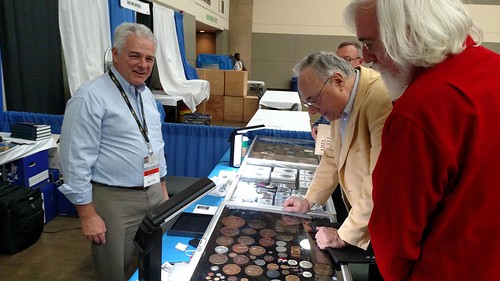
Neil with Joe Levine (yellow jacket) and Bruce Smith (red shirt)
After visiting Charlie's table I stopped to meet one of our newest E-Sylum advertisers, Todd Pollock of BlueCC Photos. Next I spoke a bit with David Hill at the ANS table about a possible visit in January. Lastly I said hello to David Lange over at the NGC table.
Castorland Jetons
I had one last stop to make - the presentation on the Castorland Jetons by Chester Sullivan and Joe Esposito.
A long display was set up at the front of the room. Where else can you see so many Castorlands in one place? Ray Williams was working the projector. I learned a few things from this talk as well.
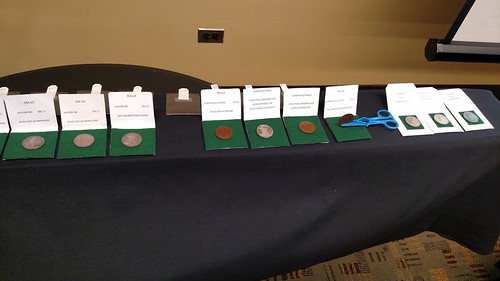
On the way out I was stopped in the hall by Mike Shutty, author of some great recent numismatic books including Lost Cents, Dead Owners: Appreciating Coins in Decay . It was the first time we'd met in person. I apologized for having had to miss his 11am Educational Forum presentation due to the competing Newman User Forum. His title was Bent, Holed and Folded: Coin Talismans at Jamestown. Later Joe Esposito wrote to me:
Mike Shutty gave a fascinating presentation on talisman coins of Jamestown; I thought that it was one of the most intriguing talks that I’ve heard in a long time.
So much numismatics, so little time. It was already time for me to head out into the Friday traffic jam to make my way home. I had a pleasant walk in the afternoon sun back to my car and pulled out of the garage at 3:30. At 6 o'clock sharp I finally pulled into a restaurant parking lot to meet my family for dinner. The show was a delight, but now I was solidly back in my real world with a wife, three kids, two in-laws and a yappy little dog named Max back at the house.
I'm lucky to live close enough to Baltimore to be able to attend these great shows without a lot of expense. I'm already looking forward to some great numismatic events in 2017.
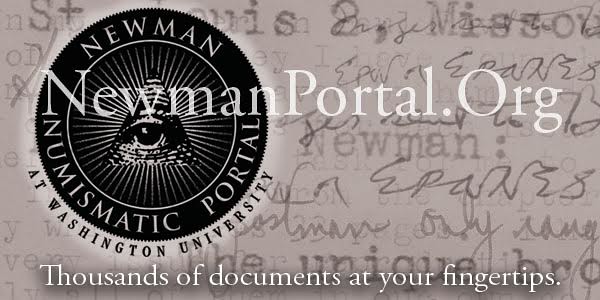
COINTALK COIN CONTEST GIVEWAY CHALLENGE
Greetings all. I will be holding a 1,100+ post coin give away. In all honesty, I was supposed to have had a very special one at my 1,000 post but things were not meant to be. Such is life. I have truly enjoyed watching and reading all the posts on Coin Talk and I felt compelled to give back to this numismatic community using this venue. I even went as far as to personally e-mail one of our hobby's biggest icons and contributors, Q. David Bowers and see if he was interested in participating in my 1,000 post.
Well much to my surprise, about a month later he responded back to my e-mail and stated that Wayne Homren, editor of The E-Sylum would be interested in publishing our little coin giveaway contest in an upcoming issue of their magazine. Mr. Homren sent me an e-mail describing their magazine,
“The E-Sylum is an electronic counterpart to our print journal, The Asylum. It's free and you don't have to be a member to subscribe. It goes out each Sunday night to over 2,000 numismatic bibliophiles, researchers, and just plain collectors. We cover a wide range of subjects and most people find something of interest in each issue”.
On top of that Q. David Bowers sent me his personal archive of quiz questions he has been compiling since 1950. His archive was a word document that was 79 pages in length full of every types of question that dealt with Numismatics as a whole. All he asked was that if we use some of his questions then to credit “From the archives of Bowers & Merena Galleries, Wolfeboro, NH.”.
OK now let’s discuss the guidelines and rules of coin give-away contest I will be holding. I am going to try and keep this as simple as possible.
To read about and enter the contest, see:
1,100 Coin Giveaway Contest
(www.cointalk.com/threads/1-100-post-coin-contest-giveway-challenge-your-numismatic-minds-great-prizes.286064/)
In the 19th century, when coin collecting was just beginning to become popular, one of the most publicized American coin rarities was featured in advertisements and news items. For a long time, Ebenezer Locke Mason, Jr., stated that he would pay $25 for a nice one:
a. 1794 silver dollar.
b. 1805/4 over date half dollar.
c. 1802 half dime.
d. 1799 Copper cent
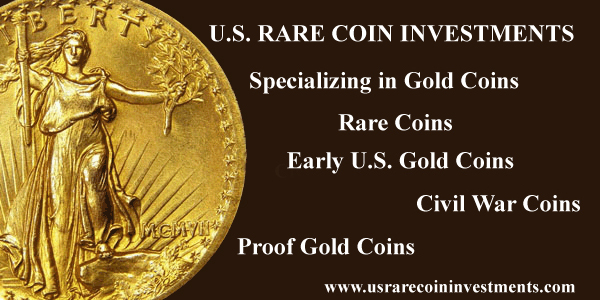
TEENAGERS DISCOVER 1,200-YEAR-OLD COIN
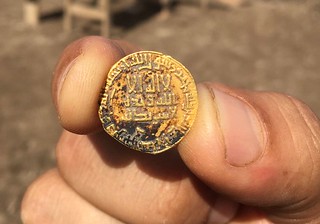 On Sunday, two teenages partaking in an archeological dig in the town of Kama in the lower Galilee discovered an ancient coin thought to be around 1,200 years old according to the Israeli Antiquities Authority.
On Sunday, two teenages partaking in an archeological dig in the town of Kama in the lower Galilee discovered an ancient coin thought to be around 1,200 years old according to the Israeli Antiquities Authority.
The coin from the 8th century CE, is inscribed with Arabic and mentions the name of the Prophet Muhammad and speaks of monotheism.
"While digging, I found a shiny coin. When I realized what it was I screamed, and we were so excited,” said Dor Yogev, who was part of student delegation taking part the archeological dig.
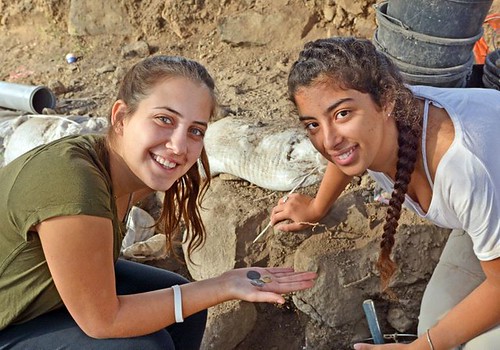
To read the complete article, see:
Teenagers discover 1,200-year-old coin in the Galilee
(www.jpost.com/Israel-News/Teenagers-discover-1200-year-old-coin-in-the-Galilee-471424)
THE BOOK BAZARRE
BROTHERS DESIGN CANADA'S NORTHERN LIGHTS COIN
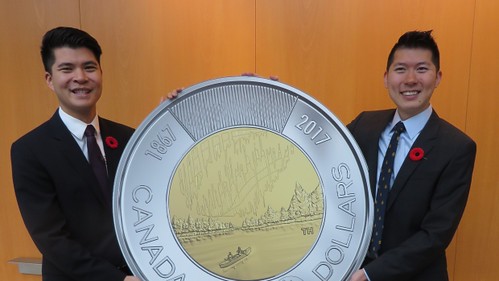
Dr. Timothy Hsia learned he was one of the winners of the Royal Canadian Mint's 2017 circulation coin series design contest from a call at the end of a long work day.
"I thought it was a patient calling and, actually, it turned out to be the Mint," said Hsia, 32, a family doctor from Richmond, B.C.
"I was so thrilled. (It) couldn't have been a better way to end that work week."
Hsia and his brother Stephen, 30, worked on the design together. The public chose the winners.
The Mint revealed the winners to the public on Wednesday. The brothers' design, which depicts the northern lights, will adorn Canada's two-dollar coins — the toonie — next spring to celebrate Canada's 150th anniversary.
The unveiling ceremony was at Richmond City Hall where the brothers were awarded a $2,000 cheque, a trip to Ottawa for two in 2017 and the special edition set of coins. Their design will be displayed on 10 million two-dollar coins.
"I've just been walking down the street and just seeing tons and tons of people, but just to think that they all have change in their pockets and that they're able to see my brother's artwork is an amazing accomplishment," said Stephen Hsia..
The brothers are both professionals; Stephen is a lawyer, and they do artwork in their spare time.
Timothy said he and his brother have worked on art projects together since they were kids, often providing feedback to one another.
It was Timothy who came up with the northern lights design. Stephen, a digital artist, helped translate the design onto the computer.
To read the complete article, see:
Richmond brothers win 'toonie' design contest for Canada's 150th anniversary
(www.cbc.ca/news/canada/british-columbia/mint-winners-richmond-brothers-toonie-1.3835555)

CANADA'S SESQUICENTENNIAL CIRCULATING COINS
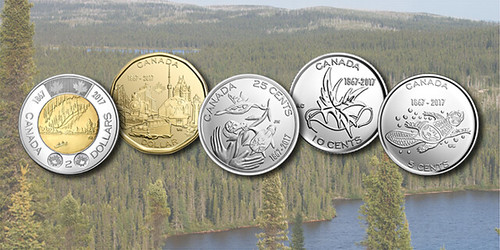
Next year, as part of the celebration of Canada’s 150th anniversary (“Canada 150,” as it’s popularly called), the Royal Canadian Mint will issue a special series of 2017-dated circulating coins. Each of the denominations ($2, $1, 25 cents, 10 cents, and 5 cents) will bear a reverse design pertaining to one of five themes in a Mint-sponsored design contest called “My Canada, My Inspiration.” The contest themes were Our Wonders, Our Character, Our Achievements, Our Passions, and Canada’s Future.
The contest was launched on March 11, 2015, when the Mint invited the public to submit designs for the series. Thousands of designs poured in, and the public cast more than one million votes online to narrow the selection. The remaining designs were reviewed by the Mint and a panel of notable Canadians, who together selected the finalists. Beginning in September 2015, Canadians voted on the winners in the five categories.
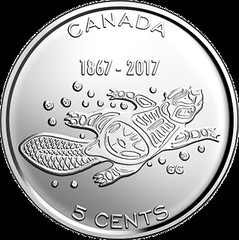 Gerald Gloade, of the Millbrook First Nation Community, was the winner of the category “Our Passions.” Gloade is especially fond of the 1967 Alex Colville–designed centennial coinage—a series that is now iconic in Canada’s numismatic history. “Having the chance to leave your own mark on a Canadian circulation coin is an amazing way to be involved in the celebration of Canada 150,” he said. “As a proud Mi’kmaw, I was inspired to reimagine the beaver of our traditional five-cent coin through the eyes of my own First Nations Culture.” Gloade’s design, which bears distinctive visual elements of Algonkian cultural heritage, was created entirely with digital tools, and will grace the reverse of the 5-cent coin in the series.
Gerald Gloade, of the Millbrook First Nation Community, was the winner of the category “Our Passions.” Gloade is especially fond of the 1967 Alex Colville–designed centennial coinage—a series that is now iconic in Canada’s numismatic history. “Having the chance to leave your own mark on a Canadian circulation coin is an amazing way to be involved in the celebration of Canada 150,” he said. “As a proud Mi’kmaw, I was inspired to reimagine the beaver of our traditional five-cent coin through the eyes of my own First Nations Culture.” Gloade’s design, which bears distinctive visual elements of Algonkian cultural heritage, was created entirely with digital tools, and will grace the reverse of the 5-cent coin in the series.
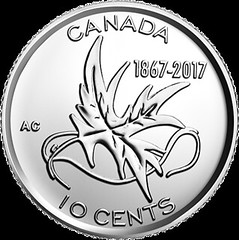 Albertan Amy Choi’s design was the winner for the “Our Character” theme. “My coin design expresses the hope that, one day, the offering of the maple leaf will be as symbolic as the offering of an olive branch,” she said. “Since Canada is known worldwide for its desire to promote peace, cooperation, and diversity, I was moved to combine the maple leaf and the dove as my way to show what I admire most about my country.” Choi’s graceful composition, “Wings of Peace,” will be featured on the reverse of the 10-cent coin.
Albertan Amy Choi’s design was the winner for the “Our Character” theme. “My coin design expresses the hope that, one day, the offering of the maple leaf will be as symbolic as the offering of an olive branch,” she said. “Since Canada is known worldwide for its desire to promote peace, cooperation, and diversity, I was moved to combine the maple leaf and the dove as my way to show what I admire most about my country.” Choi’s graceful composition, “Wings of Peace,” will be featured on the reverse of the 10-cent coin.
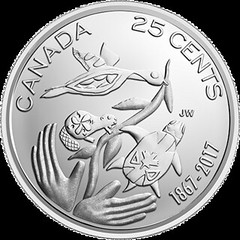 The work of nine-year-old Joelle Wong, of Ontario, will star on the reverse of the 25-cent coin. Wong’s design was the winner of the “Canada’s Future” theme. In the image, a turtle, a bird, a beaver, and a twining vine ascend from a pair of open hands, symbolizing the connection of humans with the natural world of Canada, and the need to protect it. “I love animals and green spaces and that gave me the idea of showing my hope for Canada’s future in a painting that celebrates the importance of our nature and native Canadian culture,” said Wong. “It’s amazing that so many Canadians liked my way of wishing a happy birthday to my beautiful homeland—Canada!”
The work of nine-year-old Joelle Wong, of Ontario, will star on the reverse of the 25-cent coin. Wong’s design was the winner of the “Canada’s Future” theme. In the image, a turtle, a bird, a beaver, and a twining vine ascend from a pair of open hands, symbolizing the connection of humans with the natural world of Canada, and the need to protect it. “I love animals and green spaces and that gave me the idea of showing my hope for Canada’s future in a painting that celebrates the importance of our nature and native Canadian culture,” said Wong. “It’s amazing that so many Canadians liked my way of wishing a happy birthday to my beautiful homeland—Canada!”
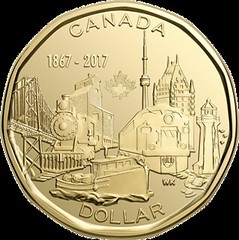 Wesley Klassen, of Ontario, created the winning design for the “Our Achievements” category. The complex design draws on the artist’s memories of family vacations, and the great engineering achievements they saw as they traveled the country. Klassen said, “I chose images that are in one way or another connected to the railroad, for which all Canadians can be forever grateful, and I’m touched that my design appealed to so many of them.” The composition holds the Lion’s Gate Bridge, a prairie grain elevator, the CN Tower, the majestic Chateau Frontenac Hotel in Quebec City, and an East Coast lighthouse, all connected by a railroad.
Wesley Klassen, of Ontario, created the winning design for the “Our Achievements” category. The complex design draws on the artist’s memories of family vacations, and the great engineering achievements they saw as they traveled the country. Klassen said, “I chose images that are in one way or another connected to the railroad, for which all Canadians can be forever grateful, and I’m touched that my design appealed to so many of them.” The composition holds the Lion’s Gate Bridge, a prairie grain elevator, the CN Tower, the majestic Chateau Frontenac Hotel in Quebec City, and an East Coast lighthouse, all connected by a railroad.
All of the obverses will feature the profile portrait of Her Majesty Queen Elizabeth II designed by Susanna Blunt. An extensive series of collector coins will be offered for the sesquicentennial, as well.

To read the complete article, see:
Canada: 2017 Sesquicentennial Circulating Coin Designs Released
(http://world.mintnewsblog.com/2016/11/canada-2017-sesquicentennial-circulating-coin-designs-released/)
THE BOOK BAZARRE
AUSTRALIA’S PRIME MINISTER ASKED ABOUT FIVE CENT PIECE
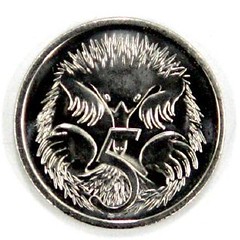 IT COSTS six cents to make each five cent piece and yet millions continue to be minted each year. But it seems even the Prime Minister thinks it could now be a waste of money to keep producing Australia’s tiniest coin.
Malcolm Turnbull said on Friday ditching the 5c coin could make sense.
IT COSTS six cents to make each five cent piece and yet millions continue to be minted each year. But it seems even the Prime Minister thinks it could now be a waste of money to keep producing Australia’s tiniest coin.
Malcolm Turnbull said on Friday ditching the 5c coin could make sense.
The great coin question first arose in May when News.com.au’s Malcolm Farr asked Treasurer Scott Morrison if it was worth producing the 5c piece given its dwindling use and the increase in electronic payments.
The minister thought the notion was a frivolity, responding “If you can get as many people as in this room again who are interested in that topic, I’ll answer your question.”
But the question has refused to go away with the Tasmanian Liberals putting the issue on the agenda of a party meeting this weekend in Launceston. The motion says the 5c piece should be scrapped as it is “rapidly becoming irrelevant”.
Turnbull, who is in Tasmania to address the meeting, was asked on Friday by local radio station LAFM whether he thought the coin should go. He was more forthcoming on the debate than his Treasurer.
“It’s a good question. I’ll be very interested to follow the local debate on that,” he said.
“You don’t see them a lot anymore, do you actually? It’s a fair point.”
To read the complete article, see:
Prime Minister Malcolm Turnbull open to scrapping the 5c coin
(www.news.com.au/finance/money/prime-minister-malcolm-turnbull-open-to-scrapping-the-5c-coin/news-story/09d4567fc58317705e3467762f1f6eb1)
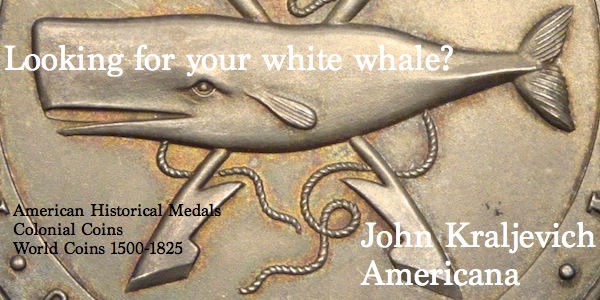
THE COIN JEWELERY OF STACEY LEE WEBBER
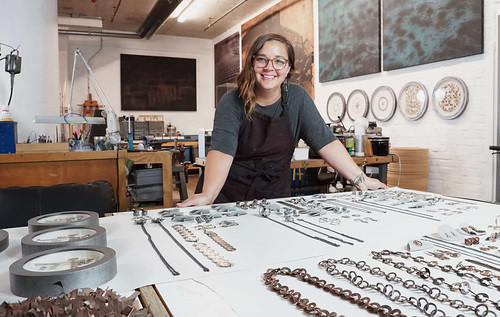
Stacey Lee Webber, 34, of Philadelphia's Frankford section: She's cashing in on an unusual niche, transforming pennies, dimes, and quarters into sculptures, striking wall art, and stylish jewelry.
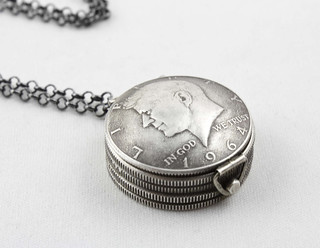 Webber studied metalsmithing and making jewelry at the University of Wisconsin-Madison, where she made a series of sculptures of tools made from pennies for her master's thesis about outsourcing and the declining value placed on American blue-collar labor. When she used the same skills to make Christmas gifts of coin jewelry for her sisters, she saw the potential to turn her art into a business. She and her husband, artist Joseph LeRoux, came to Philadelphia in search of studio space and set up shop at Globe Dye Works in 2011.
Webber studied metalsmithing and making jewelry at the University of Wisconsin-Madison, where she made a series of sculptures of tools made from pennies for her master's thesis about outsourcing and the declining value placed on American blue-collar labor. When she used the same skills to make Christmas gifts of coin jewelry for her sisters, she saw the potential to turn her art into a business. She and her husband, artist Joseph LeRoux, came to Philadelphia in search of studio space and set up shop at Globe Dye Works in 2011.
Webber uses traditional metalsmithing techniques, cutting each coin by hand with a jeweler's saw and soldering them together or bending them.
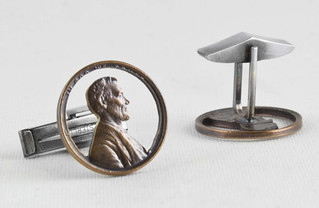 "That's why a pair of Abe Circled earrings" - each one a penny with only Lincoln's silhouette and the coin's rim intact - "are like $50 instead of 2 cents," she said. "I have to put more value into it."
"That's why a pair of Abe Circled earrings" - each one a penny with only Lincoln's silhouette and the coin's rim intact - "are like $50 instead of 2 cents," she said. "I have to put more value into it."
Along the way, she's learned more than she ever really wanted to know about legal tender: She can use only pre-1983 pennies that are pure copper, and vintage silver dimes and quarters. Some metal-alloy coins will melt under the heat of the soldering iron.
For her sculptures and vessels, she makes her own sheet metal out of rows of pennies, then bends it into shape. For wall art, flocks of birds, herds of buffalo, or rows of presidential silhouettes are tacked into wooden panels with pins or held in place with a thin layer of resin.
Webber has her eye on a new water-jet laser cutter, Wazer, a design by University of Pennsylvania engineering graduates that recently raised $1.4 million on Kickstarter. That tool will be ready next fall.
Until then, she's still cutting pennies one at a time. She's using them in collaborations, like metal lids for ceramic pots by Justin Rothshank. And she recently bought her first gold coin, though she hasn't worked up the nerve to cut into it. For now, she said, "I still can think of zillions of things with pennies I want to do, but I just haven't had time to do them yet."
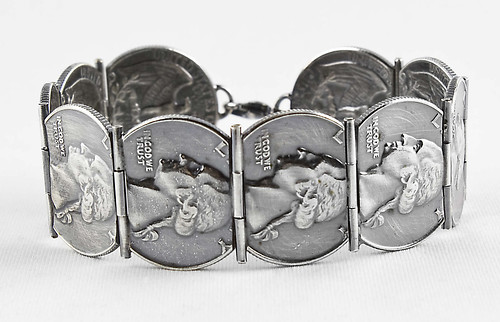
To read the complete article, see:
How a Philly artist turns loose change into stunning jewelry
(www.philly.com/philly/home/20161106_How_a_Philly_
artist_turns_loose_change_into_stunning_jewelry.html)

ENGRAVED COINS OF SHAUN HUGHES
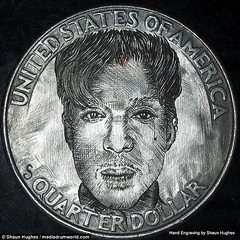
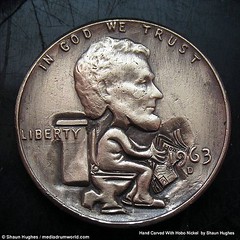
Prince andLincoln'sdialy Constitutional
The labour of love engravings were carried out by artist Shaun Hughes, 53, from Essex who began recording his work to inspire others who want to take up the trade.
Other amazing engravings include a portrait of the musician Prince on a US quarter, Abraham Lincoln sitting on a toilet on a US penny and Roman centurion carved onto a 1,000-year-old Constantine Roman coin.
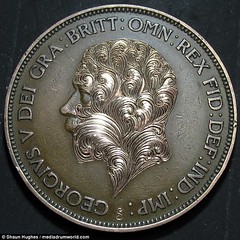
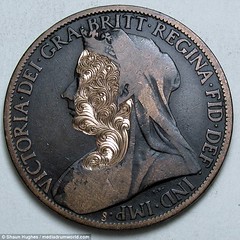
George and Victoria
Shaun took up the practice after running a jewellery repair shop for 15 years.
He got started with the help of a small worldwide community of engravers promote by The Original Hobo Nickel Society and The Love Token Society.
'Anyone who wants to learn the art of hand engraving can start on a coin and have something of interest and value from the very first try,' he said.
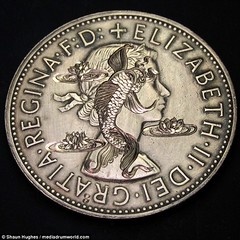
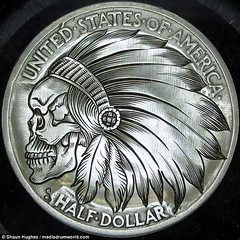
Fishy Liz and Skull Chief
'Modern engraving uses microscopes and power assisted engravers. It's like a tiny jack hammer that you have to steer. 'I have mostly used a GRS Gravermach and a Nikkon SMZ800 Microscope.
'I make most of my other tools as I'm a bit of a mad inventor.'
'When I engrave it's a bit like a meditation. I forget I'm cold or thirsty until I stop engraving. I don't take many commissions, so even though I can engrave for up to 12 hours some days it doesn't seem like work.'
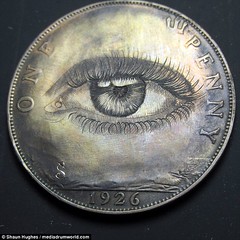
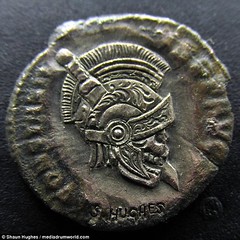
To read the complete article, see:
Now that's a pretty penny! Engraver creates incredible artworks from coins showing Prince and Abraham Lincoln on the toilet
(www.dailymail.co.uk/news/article-3908026/Now-s-pretty-penny-Engraver-creates-incredible-artworks-coins-showing-Prince-Abraham-Lincoln-toilet.html)

FEATURED WEB SITE: COIN TALK
This week's Featured Web Site is Coin Talk, an online numismatic discussion forum.

www.cointalk.com
